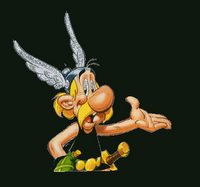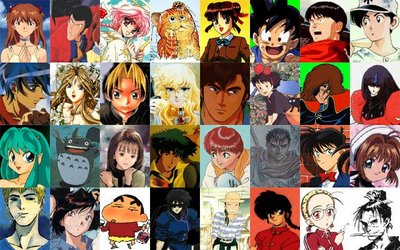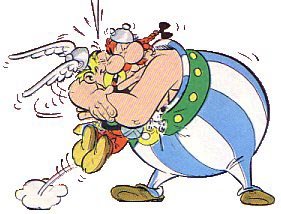

"Comic books or bandes dessinees as they are called in the French-speaking world have been a significant part of French culture since the late 30s. But European comics are loosing ground to their popular Japanese counterparts and Samurais from the land of the rising sun threaten to turn Asterix into nothing more than a vague memory," wrote Emma Charlton in a recent article. "With its talking cats and wandering samurais, Japanese manga is taking France's booming comic-book market by storm, challenging home-grown icons like Asterix as young readers lap up the eastern fare."
"Talking cats?" asks the Manga blogger, writing about another article that had appeared in the media. "France’s publishing giants," he writes, "who saw the manga wave coming, have managed to salvage their overall market share by licensing and distributing most of the Japanese titles sold in France. He quotes Joseph Verhoeven, a 76-year-old retiree and fan of comic book artwork, as tut-tutting over what he calls the manga “invasion”. "It’s an easy option for authors, but there’s a lot less subtlety, fewer facial expressions,” he said, as he pored through the bookstore’s shelves for the latest French or Belgian gem."
Ask any Frenchman and he will tell you he was raised on bandes dessinees or comic books. Every French boy's first hero is the intrepid boy-reporter Tintin, the creation of George Remi -- born Brussels Belgium 1907 died 1983 -- aka Herge) and Asterix needs no introduction to even non-French -- we all know the creation of the two comic geniuses Rene Goscinny and Albert Uderzo. Asterix and his side-kick Obelix's adventures are far more than just a comic strip. They are commentary on European national stereotypes, funny swipes at the achievements of the Roman Empire, the British Empire, the every empire...., with humurous -- and often satirical charicatural cameo appearances of pretty much anyone who ever was someone, and social commentary on our current mores and values dished up with such subtlety under the brash veneer of Obelix's anything-but-subtle intolerance and bravura. The Asterix comics have been translated into 29 different languages- even into Latin - and this transaltion is frequently used in many schools where Latin is taught in order to loosen up an otherwise rather dry matter.
According to Charlton's report, last year alone more than 4,000 new comic book titles hit the shelves in France and French-speaking Belgium and Switzerland with more than 40 million copies sold.


"But in recent years, characters with names like "Kakashi" or "Mamoru" have been jostling for elbow room with their French-sounding counterparts, with manga now making up 40 percent of all comic book sales in France.
For the first time in its 34-year history, the Angouleme comic book festival last year had to set aside a dedicated manga showroom, with debates and screenings of anime films, the motion picture answer to manga, while half a dozen Japanese titles were in the running for the top prize."
Some early publishers like Glénat, adapted manga using the Western reading direction and its induced work of mirroring each panel and graphical signs, and also using a quality paper standard to the Franco-Belgian comics , while others, like J'ai Lu, were faithful to the original manga culture and not only kept the original, inverted, Japanese direction reading but also used a newspaper standard, cheap quality, paper just like in Japan. The Japanese manga was such an important cultural phenomenon that it quickly influenced French comics authors. A new "French manga" genre emerged, known as "La nouvelle manga" in reference to the French Nouvelle Vague, a significant part of French culture since the late 30s.

Today France is noted for having a particularly strong and diverse manga market. In the 1990s, France became the second country, after Japan, reading manga worldwide. A cultural reason for the sheer popularity and diversity of manga in this country is due to it having a well established and respected comics market of its own. Other reasons are socio-historical, an exceptionnal reduced number of TV channels in the 1970s and 1980s explains the powerful impact the Japanese animation had on the audience, since there was not much choice Japanese animation quickly became mainstream. Since its introduction in the 1990s, manga publishing and Anime broadcasting are intertwined in France, where the most popular and exploited Shonen, Shojo and Seinen TV series were imported in their paper version. Therefore Japanese comics were naturally and early accepted by a large juvenile public who was already familiar with the series and received the manga as part of their own culture. A strong parallel backup was the emergence of Japanese video games, Nintendo/Sega, which were mostly based on manga and anime series.
 One of the interesting aspects of an eastern craze coming to Europe, is what is called "flipping". Since Japanese is usually written from right to left in works of fiction, manga is drawn and published this way in Japan. When various titles were first translated to other languages, the artwork and layouts were flipped and reversed in a process known as "flopping", so that the book could be read from left-to-right. However, various creators -- such as Akira Toriyama, did not approve of their work being modified this way, and requested that foreign versions retain the right-to-left format of the originals. Soon, due to both fan demand and the requests of creators, more publishers began offering the option of right-to-left formatting, which has now become commonplace. Left-to-right formatting has gone from the rule to the exception.
One of the interesting aspects of an eastern craze coming to Europe, is what is called "flipping". Since Japanese is usually written from right to left in works of fiction, manga is drawn and published this way in Japan. When various titles were first translated to other languages, the artwork and layouts were flipped and reversed in a process known as "flopping", so that the book could be read from left-to-right. However, various creators -- such as Akira Toriyama, did not approve of their work being modified this way, and requested that foreign versions retain the right-to-left format of the originals. Soon, due to both fan demand and the requests of creators, more publishers began offering the option of right-to-left formatting, which has now become commonplace. Left-to-right formatting has gone from the rule to the exception.Translated manga also often includes cultural notes for details of Japanese culture that may not be familiar to foreign audiences.

Click on Link:
Chateau Lalinde : The perfect venue for your event
TAGS: Events Rent a chateau France
Chateau
Manga Asterix Holidays in France Recipes







